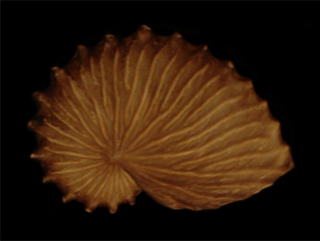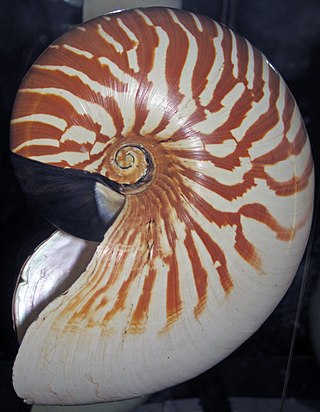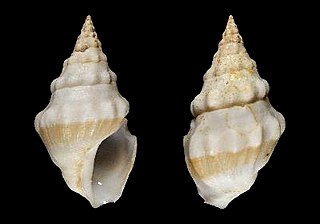
The nautilus is an ancient pelagic marine mollusc of the cephalopod family Nautilidae. The nautilus is the sole extant family of the superfamily Nautilaceae and the suborder Nautilina.

The chambered nautilus, also called the pearly nautilus, is the best-known species of nautilus. The shell, when cut away, reveals a lining of lustrous nacre and displays a nearly perfect equiangular spiral, although it is not a golden spiral. The shell exhibits countershading, being light on the bottom and dark on top. This is to help avoid predators, because when seen from above, it blends in with the darkness of the sea, and when seen from below, it blends in with the light coming from above.

A cenote is a natural pit, or sinkhole, resulting when a collapse of limestone bedrock exposes groundwater. The term originated on the Yucatán Peninsula of Mexico, where the ancient Maya commonly used cenotes for water supplies, and occasionally for sacrificial offerings. The name derives from a word used by the lowland Yucatec Maya—tsʼonoʼot—to refer to any location with accessible groundwater.

Aliger gigas, originally known as Strombus gigas or more recently as Lobatus gigas, commonly known as the queen conch, is a species of large sea snail, a marine gastropod mollusc in the family of true conches, the Strombidae. This species is one of the largest molluscs native to the Caribbean Sea, and tropical northwestern Atlantic, from Bermuda to Brazil, reaching up to 35.2 centimetres (13.9 in) in shell length. A. gigas is closely related to the goliath conch, Lobatus goliath, a species endemic to Brazil, as well as the rooster conch, Aliger gallus.

Argonauta nouryi, also known as Noury's argonaut, is a species of pelagic octopus. The female of the species, like all argonauts, creates a paper-thin eggcase that coils around the octopus much like the way a nautilus lives in its shell. The shell is usually approximately 80 mm in length, although it can exceed 90 mm in exceptional specimens; the world record size is 95.5 mm.

Argonauta hians, also known as the winged argonaut, muddy argonaut or brown paper nautilus, is a species of pelagic octopus. The common name comes from the grey to brown coloured shell. The Chinese name for this species translates as "grey sea-horse's nest". The female of the species, like all argonauts, creates a paper-thin eggcase that coils around the octopus much like the way a nautilus lives in its shell. The eggcase is characterised by a wide keel that gives it a square appearance, few rounded tubercles along the keel, and less than 40 smooth ribs across the sides of the shell. The shell is usually approximately 80 mm in length, although it can exceed 120 mm in exceptional specimens; the world record size is 121.5 mm.

Argonauta cornuta is a species of pelagic octopus belonging to the genus Argonauta. The female of the species, like all argonauts, creates a paper-thin eggcase that coils around the octopus reminiscent of the way a nautilus lives in its shell. The shell is usually approximately 80 mm in length, although it can exceed 90 mm in exceptional specimens; the world record size is 98.6 mm.

Argonauta pacifica, also known as the Pacific argonaut, is a species of pelagic octopus. The female of the species, like all argonauts, creates a paper-thin eggcase that coils around the octopus much like the way a nautilus lives in its shell. The shell is usually approximately 150 mm in length, although it can exceed 200 mm in exceptional specimens; the world record size is 220.0 mm.

Argonauta bottgeri, also known as Böttger's argonaut, is a species of pelagic octopus belonging to the genus Argonauta. The female of the species, like all argonauts, creates a paper-thin eggcase that coils around the octopus much like the way a nautilus lives in its shell.

The Palau nautilus is a nautiloid mainly found off of Palau in the Western Carolines. It can be found on fore reef slopes, at depths of 95m-504m (311'-1,653'), though typically preferring a range of 150m-300m (492'-984'), where water temperatures stay around 16.6 °C (61.88°F) and do not go much lower than 9.4 °C (48.92°F). N. belauensis are highly mobile, epibenthic scavengers and opportunistic predators which rely mostly on scent for finding food. They are active both diurnally and nocturnally within their preferred depth ranges, although most shallow-water incursions are, generally, nocturnal events that coincide with greatly diminished fish activities.

Nautilus is a marine cephalopod genus in the mollusk family Nautilidae. Species in this genus differ significantly, morphologically, from the two nautilus species in the adjacent sister-taxon Allonautilus. The oldest fossils of the genus are known from the Late Eocene Hoko River Formation, in Washington State and from Late-Eocene to Early Oligocene sediments in Kazakhstan. The oldest fossils of the modern species Nautilus pompilius are from Early Pleistocene sediments off the coast of Luzon in the Philippines.

Nautilus stenomphalus, also known as the white-patch nautilus, is a species of nautilus native to the Great Barrier Reef. N. stenomphalus is very similar to N. pompilius and may in fact represent a subspecies. It is separated by the absence of a thickened callus and the presence of white patches in the umbilical and shoulder regions of the shell. The sheaths of this species have scalloped edges compared with the smooth sheaths of N. pompilius. N. stenomphalus also differs slightly in hood ornamentation. The shell is usually up to around 180 mm in diameter, although the largest specimen ever recorded measured 201 mm.

Allonautilus scrobiculatus, also known as the crusty nautilus or fuzzy nautilus, is a species of nautilus native to the waters around New Guinea, specifically New Britain and Milne Bay, and the Solomon Islands. A. scrobiculatus is recognizable by the large open umbilicus, which is around 20% of the shell diameter at its widest point. This species, along with the closely related A. perforatus, were originally placed in the genus Nautilus, but have recently been given their own genus on account of significant morphological differences. The most obvious are features of the shell, including crease and an encrusting layer (periostracum) that covers most of the shell. Gills and reproductive structures also differ significantly from members of the genus Nautilus. The shell is usually up to around 18 cm in diameter, although the largest specimen ever recorded measured 21.5 cm. The species was thought to have gone extinct after 1986, but was rediscovered in July 2015.

Laevistrombus canarium is a species of edible sea snail, a marine gastropod mollusc in the family Strombidae. Known from illustrations in books dating from the late 17th century, L. canarium is an Indo-Pacific species occurring from India and Sri Lanka to Melanesia, Australia and southern Japan. The shell of adult individuals is coloured from light yellowish-brown to golden to grey. It has a characteristic inflated body whorl, a flared, thick outer lip, and a shallow stromboid notch. The shell is valued as an ornament, and because it is heavy and compact, it is also often used as a sinker for fishing nets.

Pleuroploca trapezium, common name : the trapezium horse conch or striped fox conch, is a species of sea snail, a marine gastropod mollusk in the family Fasciolariidae, the spindle snails, the tulip snails and their allies.
The Loyalty Islands blind snake is a species of snake in the family Typhlopidae. The species is endemic to Melanesia.

Oocorys sulcata is a species of large sea snail, a marine gastropod mollusc in the family Cassidae, the helmet snails and bonnet snails.

Clavus boucheti is a species of sea snail, a marine gastropod mollusc in the family Drilliidae.

Tritonoturris lifouana is a species of sea snail, a marine gastropod mollusk in the family Raphitomidae.

Panopea bitruncata is a species of marine bivalve commonly known as the Atlantic geoduck or Atlantic geoduck clam. These clams like their more famous Pacific relative P. generosa have an enlarged siphon that can extend to great lengths or contract to just barely poke out of the shell. They are generally smaller in comparison to the Pacific species though still constitute a sizable mollusc as they cannot fully retract their siphon.
























